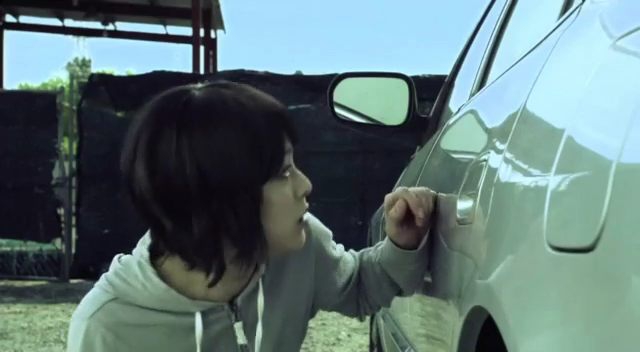Editor's Note: In each Wild Women with Steak Knives entry, author Alexandra Heller-Nicholas examines a woman-directed horror film that's been largely overlooked or forgotten. Read them all here!
Sometimes it takes a foreign eye to look at a given country and its culture to reveal a perspective locals don't - or can't - quite see. There are lots of examples, of course, but the point is perhaps nowhere more evident than Canadian director Ted Kotcheff's 1971 Australian-set nightmare vision in Wake In Fright. This film packed such a mighty punch that it almost single-handedly kickstarted the Australian New Wave later that decade. When it comes to non-American eyes casting their gaze over the US, again, horror is no stranger; Bruno Dumont's eye-wateringly brutal 2003 Twentynine Palms was a key film in helping to define the New French Extremity, itself a term coined by a non-French critic to describe perceived trends in that particular national cinema.
Twentynine Palms is a curious point of reference when thinking about Kayoko Asakura's US-set 2013 feature It's A Beautiful Day; while her film adds a supernatural edge to what plays out as a rural home invasion film on the surface, something about the unsettled, violent world in which that film is set makes it feel at critical points that it and Twentynine Palms - while very different movies by very different filmmakers - could almost be set in the same universe.
Like Dumont's film, It's A Beautiful Day is set in a barren Californian desert scape where unwitting, carefree tourists have erroneously ventured. Violence explodes on screen even before the film's opening titles run as a lost couple drives through the dry, empty landscape only to stop when they see an unmoving body lying on the road. Unbeknownst to them, until it's too late, it's a trap - rednecks Henry (Adam LaFramboise) and his brother Victor (Julian Curtis) are faking an injury to kill and rob the owners. However, Victor fears Erica (Nanako Ohata) might have seen him dump the car at a nearby store this time.

Erica is a Japanese student traveling with friends to an isolated cabin to party, celebrating the completion of their university studies. Amongst them is the film's main character Ah-Jung (Kkobbi Kim), the only Korean amongst the group and the only one who can speak English. Having no shared language with the strangers she finds herself with, Ah-Jung quickly realizes that she has been invited only to help cover expenses, and the others virtually ignore her. As she prepares to leave the cabin the morning after arriving, Victor and the off-the-chain sadist Henry have something else in mind as they hunt the tourists down. A strange supernatural event complicates things even further.
It's A Beautiful Day plays well as a straight home invasion film; the performances are compelling, with LaFramboise, in particular, a minor miracle-made flesh for those of us who have ever wondered what a Hemsworth in an insanely violent horror film might look like. The supernatural twist will either win you or lose you, but the film admirably does not stop to see if we're keeping up; it clearly gives zero fucks whether we are on board or not, so committed to its bit as it is.

The film's superpower that makes it rise above similar plots is the canny way that Ah-Jung's trip is presented as a nightmare before the actual horror stuff properly begins. Western movies sometimes have a nasty habit of presenting "white" and "non-white" characters as a kind of reductive binary, a shorthand for "us" and "them ."But what Asakura does here is something very different; by amplifying the social and practical language barriers between Korean Ah-Jung and her Japanese companions, we have no choice but to think about racial and cultural differences more complexly.
Asakura was born in Tokyo in the late 1970s and has cited Tobe Hooper's The Texas Chain Saw Massacre as an influence, which comes as little surprise watching It's a Beautiful Day. The vicious, ugly portrait she paints of Victor's homelife with his deeply unhinged older brother is one laced with a sense of tragedy as much as horror, certainly one of the film's more subtle inheritances from Hooper's movie.
She would go on to make other horror movies - Girls, Dance with the Dead in 2015 and Dokumushi in 2016 - which, while solid enough, don't quite share the same elegant, demented flourish that is the signature of It's a Beautiful Day. Running just under a sleek 80 minutes, this film has an eloquence that demonstrates it is helmed by a filmmaker fully immersed and confident in their vision of what they want their movie to be. It's a Beautiful Day is an ultraviolent dream come true for those who want their J-horror with a twist.






